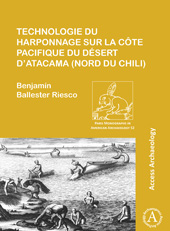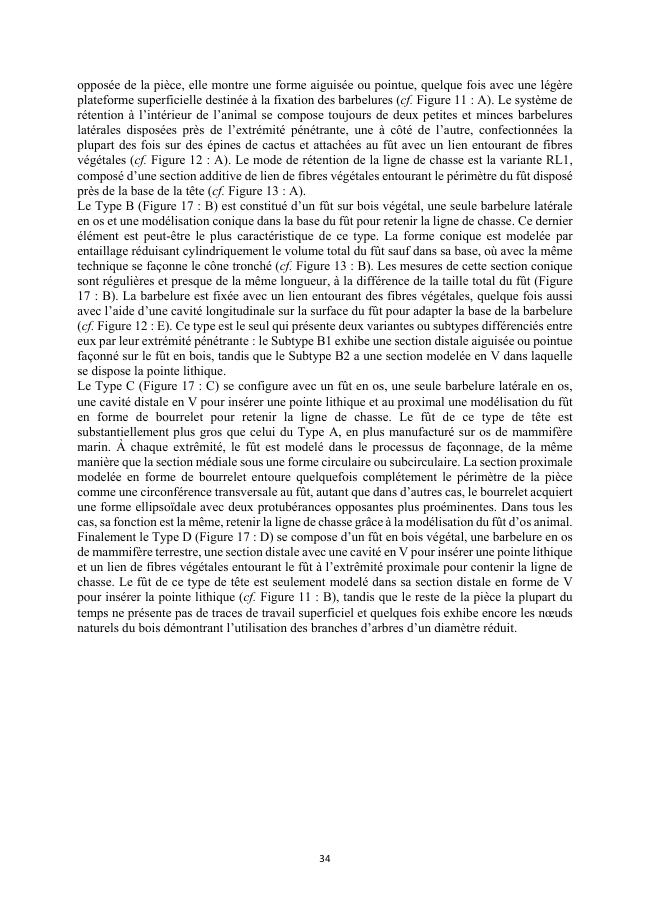Technologie du harponnage sur la côte Pacifique du désert d'Atacama (nord du Chili)
78 p.
These objects do not have a single purpose. This is the central premise that guides the research within this book. Throughout the volume the reader will follow a representation of a marine hunter-gatherer society, a projection deriving from one of its iconic and most important material assets, the harpoon. This very technical object will be studied not only for its most evident function - hunting at sea - and the work delves into the structural, symbolic, technological and world-building aspects of the human societies that used them. To achieve this goal the text begins with a judgment about the role of marine hunting, its prey, and the agents involved in different coastal societies on the American continent, in order to create a comprehensive framework of reference for the subject. It continues by focussing on clarifying, defining and discussing the concept of harponage from technology compared with other historical and ethnographic cases of marine hunters across the globe. A typology of harpoon points from.
the Atacama Desert is presented, with classification based on their technical attributes, constituent units, composition features and articulation mechanisms, in order to evaluate the chronological scope and geographical distribution of each one of the types of harpoon heads from the last 7000 years of coastal history. The text then explores the multiple values and meanings of the harpoons of the Atacama Desert. The book finally examines the social reasons that influenced the development of an incredibly sophisticated and complex technology of marine hunting. Inferences that take it out of the sea and away from hunting, towards hypotheses that seek answers in the cultural determinism stemming from technical decisions, to utilise technology as another mechanism to establish and strengthen social bonds in the construction of worlds between different agents and collectives, and no longer as a simple tool to satisfy subsistence needs. | Les objets n'ont pas un seul objectif. Prémisse centrale qui guide le dénouem
ent de ce livre. Dans les pages suivantes le lecteur trouvera une réflexion sur une société des chasseurs-collecteurs marins à partir d'un de ces biens matériaux iconiques et un des plus importantes, le harpon. Cet objet technique sera étudié hors de sa fonction la plus évidente, au-delà de la chasse marine, pour pénétrer les aspects structurels, symboliques, technologiques et de construction du monde de ces collectifs humains. Pour entreprendre ce défi, le texte nous submerge dans un premier temps dans une révision critique sur le rôle de la chasse marine, leurs proies et les agents impliqués dans ces activités et dans différentes sociétés côtières du continent américain, afin de pourvoir un cadre de référence adéquate sur cette thématique. Dans un deuxième moment, nous nous centrons dans l'éclaircissement, la définition et la concrétisation du concept de harponnage depuis la technologie comparée avec d'autres cas historiques et ethnographiques de chasseurs-cueilleurs du monde. Une typologie de têtes de harp
on pour le désert d'Atacama est ensuite présentée, fondée sur leurs solutions techniques, leurs unités constitutives, leurs normes de composition et leurs mécanismes d'articulation, pour évaluer ensuite la portée chronologique et la distribution géographique de chaque type au cours des dernières 7000 années d'histoire littorale. Par la suite, le texte tente d'explorer les multiples valeurs et significations des harpons du désert d'Atacama. Dans sa partie finale, notre récit aborde les raisons sociales qui ont permis le développement d'une technologie de chasse marine aussi sophistiquée et complexe. Interprétations qui nous emmènent hors de la mer et loin de la chasse, vers des hypothèses qui cherchent des réponses sur les contraintes culturelles qui se trouvent derrière les décisions techniques, pour concevoir à la technologie comme un mécanisme employé afin d'établir les liens sociaux dans la construction des mondes et rapprocher différents agents sociaux et collectifs, plus que comme un simple outil destiné
à satisfaire des besoins de subsistance. | Los objetos no tienen un solo objetivo. Esta es la premisa central que guía el desenlace de este libro. A lo largo de sus páginas el lector conocerá una reflexión acerca de una sociedad cazadora-recolectora marina a partir de uno de sus bienes materiales icónicos y más importantes, el arpón. Este objeto técnico será estudiado fuera de su función más evidente, más allá de la caza en el mar, para adentrarse en aspectos estructurales, simbólicos, tecnológicos y de construcción de mundo de estos colectivos humanos. Para llevar a cabo este programa, el texto se sumerge en una primera instancia en un juicio acerca del rol de la caza marina, sus presas y los agentes involucrados en diferentes sociedades costeras del continente americano, con tal de crear un marco de referencia comprensivo y adecuado sobre el tema. En segundo lugar, se aboca a clarificar, definir y concretizar el concepto de arponaje desde la tecnología comparada con otros casos históricos y etnográficos de.
cazadores marinos del planeta. Se presenta una tipología de cabezales para el desierto de Atacama fundada en sus soluciones técnicas, unidades constitutivas, normas de composición y mecanismos de articulación, para luego evaluar el alcance cronológico y la distribución geográfica de cada uno de los tipos de cabezales de arpón definidos para los últimos 7000 años de historia litoral. Posteriormente, el texto intenta explorar en torno a los múltiples valores y significados de los arpones del desierto de Atacama. El libro indaga en su desenlace final acerca de las razones sociales que dieron cabida al desarrollo de una tecnología de caza marina tan sofisticada y compleja. Inferencias que lo llevan fuera del mar y lejos de la caza, hacia hipótesis que buscan respuestas en las condicionantes culturales tras las decisiones técnicas, para concebir a la tecnología como un mecanismo más para entablar y estrechar lazos sociales en la construcción de mundos entre distintos agentes y colectivos, y ya no como una simple.
herramienta para satisfacer necesidades de subsistencia. [Publisher's text].
Special access authorizations may apply; please contact us for further information.
-
Informazioni
ISBN: 9781789690286
MATERIE
PAROLE CHIAVE
- Chile, Prehistory, Early Man, Harpoon, Hunter-Gatherer



